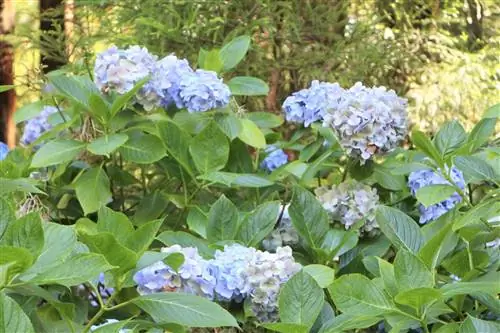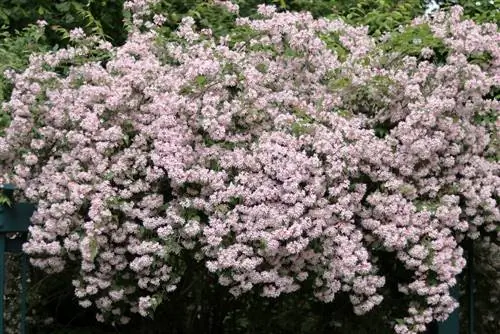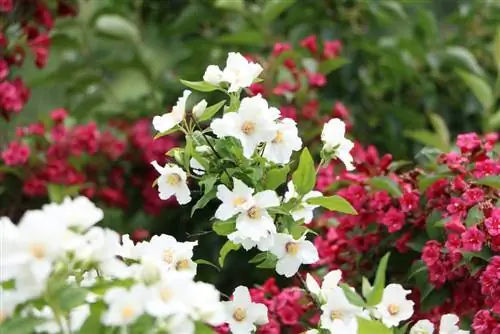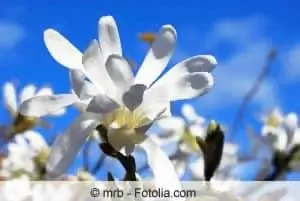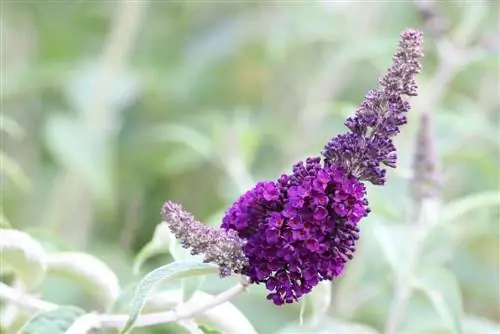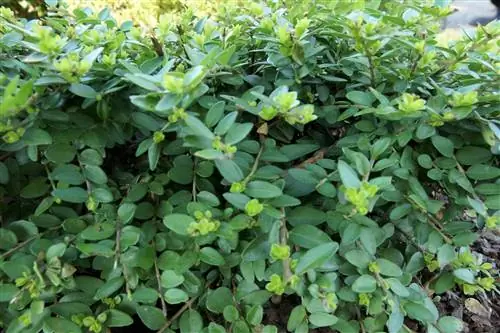- Author admin [email protected].
- Public 2023-12-17 03:39.
- Last modified 2025-01-24 12:45.
If you want to create a special and, above all, richly blooming hedge, you should take a look around at the hydrangea bushes. Both some farmer's hydrangeas and the so-called panicle hydrangeas are suitable for a hedge. While the former produce the familiar spherical flowers, panicle hydrangeas bloom as long panicles that can be up to 30 cm long. Both varieties are hardy, perennial and bloom from summer to autumn, depending on the type.
Recommended varieties
If you have decided on a hydrangea hedge, you should only look for suitable varieties when choosing plants. It is also crucial how high you want the hedge to be. The farmer's hydrangeas grow to a height of approximately one meter. The panicle hydrangeas grow up to two meters high.
Tip:
In the trade, a distinction is made between cutting groups 1 and 2. Most farmer's hydrangeas belong to cutting group 1. They are not suitable for hedge planting. Pruning group 2 includes panicle hydrangeas and some types of farmer's hydrangeas. They are well suited for strong pruning, including hedge planting.
Pranicle hydrangeas (Hydrangea paniculata)
Almost all types of panicle hydrangeas are characterized by their good tolerance to cutting. They also tolerate sunny locations and their flowers exude a delicate scent. This property also makes them attractive to insects. In autumn the leaves change color and in winter the leaves fall off. You should take this into account when planning your hedge.
- Hydrangea paniculata 'Pink Lady': Snow-white, cone-shaped flowers characterize this variety. In late summer the flowers turn pink. The foliage turns reddish in autumn. The Pink Lady feels comfortable in loose, humus-rich soil in a sunny to partially shaded location.
- Hydrangea paniculata 'Vanilla Fraise': This hydrangea grows lush in height and width. The flowers are creamy white and turn from pink to dark red over time. It blooms for a long time from the end of July to November. During the flowering period it is very thirsty.
- Hydrangea paniculata 'Kyushu': The Kyushu is an attractive wild form of the panicle hydrangea. The white panicle flowers bloom from July to September. They also exude a pleasant scent and are often visited by bees.
- Hydrangea paniculata 'Limelight': Limelight stands out because of its particularly wide, cone-shaped panicles. At first they bloom delicate green, then become pure white and towards the end pink. They bloom from July to around mid-October. It is particularly robust and hardy.
Farmer Hydrangeas (Hydrangea macrophylla)
When it comes to farmer's hydrangeas, you should find out in more detail in advance which species are suitable for a hedge. Most of them only produce flowers on the previous year's shoots. This characteristic is not particularly suitable for hedge trimming as there will be few to no flowers the next year after pruning. In some varieties, lush flowers also form on the new shoots. Anyone who prefers the typical, spherical pink to blue flowers will find what they are looking for here.
Hydrangea macrophylla 'Endless Summer': Depending on the soil, its ball-shaped flowers bloom up to 20 cm in diameter, pink to blue. The name says it all, because it produces new flowers every 6 weeks. The flowers are particularly well expressed in front of the particularly large, green leaves. It is extremely winter hardy. There is also a white flowering variety of this variety with the same characteristics, 'The Bride'
Hydrangea arborescens or forest hydrangea: There are several species here. All are characterized by very tall growth and large, white, lush flowers.
'Annabelle' forms very large white flower balls and is therefore also called snowball hydrangea. 'Grandiflora' is widespread and produces greenish-white flowers. The 'Hayes Starburst' with its white double flowers also offers an enchanting picture as a hydrangea hedge
Hydrangea aspera or velvet hydrangea: Velvet hydrangeas are an old variety. It gets its name from its leaves, which are noticeable because of their fine hairs on their surface. They grow very lush and tall. The flowers are umbellate. Small white flowers frame the edge, the center with its rich blue-violet.
Tip:
A hydrangea hedge made from different varieties creates a particularly attractive picture. Here you can vary with different colors and flowering times.
Planting
Once you have found the right variety, you can start planting. The location is partially shaded to sunny, depending on the variety. Most varieties do not tolerate full midday sun. The soil is best neutral to acidic. Some farmer's hydrangeas are particularly attractive when they sprout blue flowers in acidic soil. The best planting time is from August to September. If the soil is not acidic enough (a pH value below 5.5 is ideal), you can mix the garden soil with ericaceous soil before planting.
The planting holes are dug at the appropriate distances from each other, about twice as large as the pot ball is. If the bushes are bare root, they should be submerged in water for at least 2 to 3 hours beforehand. Place plants with root balls in the water bath until no more bubbles rise to the surface. The distance from other plants should be 70-80 cm. The individual plants in the hedge should be about 50 cm apart for farmer's hydrangeas and up to 100 cm apart for panicle hydrangeas. The distance to the property line must be maintained in accordance with the respective state regulations so that disputes do not arise. The plants are then inserted into the prepared holes, preferably too shallow rather than too deep. Then it is filled with a mixture of garden soil and compost. Started and watered carefully. After the water has absorbed, loosen the soil again and mulch it for the winter.
Care
Caring for the hydrangea hedge is not very complicated:
- Water abundantly in dry times, especially during flowering.
- For fertilization, it is sufficient to apply a layer of compost in spring or an organic-mineral fertilizer for ornamental trees.
- The panicle hydrangea can be cut back heavily in spring, to around a third.
- Farmer hydrangeas suitable for hedge planting can be cut back just like panicle hydrangeas.
- Since most varieties are hardy, they do not require winter protection.
Conclusion of the editors
A hedge made of hydrangea bushes is an attractive privacy screen all summer long. Thanks to many new breeds, there is a large selection of varieties that are compatible with cutting. The panicle hydrangeas are very robust and attract beneficial insects. Hydrangeas are hardy. However, they lose their leaves in winter, but not without beautiful foliage discoloration after a long flowering period.
What you should know about the hydrangea bush in brief
Both the smaller farmer's hydrangeas and the panicle hydrangeas are suitable as a shrub for the garden or as a hedge. The former grow to a height of around one meter, the latter to around two. There is also a difference in the shape of the flowers between these two genera, because as the name suggests, panicle hydrangeas form long panicles on which the flowers hang. These panicles can grow up to 30 cm long.
Planting and caring for it
- A hydrangea bush is best suited to a bright, partially shaded and somewhat sheltered place.
- However, it does not tolerate direct sun and especially the midday sun very well.
- It needs a lot of water and should be watered abundantly, especially during the flowering period.
- A location near a pond is particularly suitable, but hydrangeas cannot tolerate waterlogging.
In general, hydrangeas need a soil with a low pH value, but this is particularly important for varieties with blue flowers, because otherwise they change their flower color and only produce pink flowers. A pH value below 5.5 is ideal. To achieve this, the garden soil can be mixed with ericaceous soil.
- When planting, make sure that the planting hole should be about twice as big as the pot ball.
- The hydrangeas only need winter protection in very cold areas because they are hardy.
Bloom and cut
- Most farmer's hydrangeas only bloom on last year's shoots and form the buds for the next year during their flowering period.
- Pruning therefore results in fewer flowers next year and is best avoided altogether.
- Exceptions in which flowers also form on new shoots are the varieties Hydrangea macrophylla Endless Summer, Hydrangea arborescens or forest hydrangea, Hydrangea aspera or velvet hydrangea.
- In contrast, there are many varieties of panicle hydrangeas that also produce flowers on the new shoots.
- It can therefore be cut back if the hedge has become too high or too wide.
- This cut is best done in the winter months, but only during times when the temperature is above freezing.
Creating a hedge
- The farmer's hydrangea, which grows just over a meter high, is also suitable for a low hedge.
- The panicle hydrangeas, on the other hand, are more suitable for a high hedge that is intended to provide privacy over time.
- For small farmer's hydrangeas, a planting distance of 50 cm is sufficient; for panicle hydrangeas it should be about one meter.

